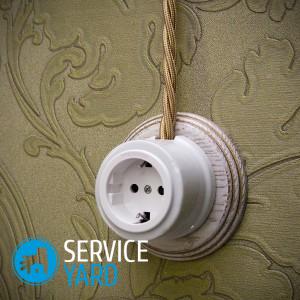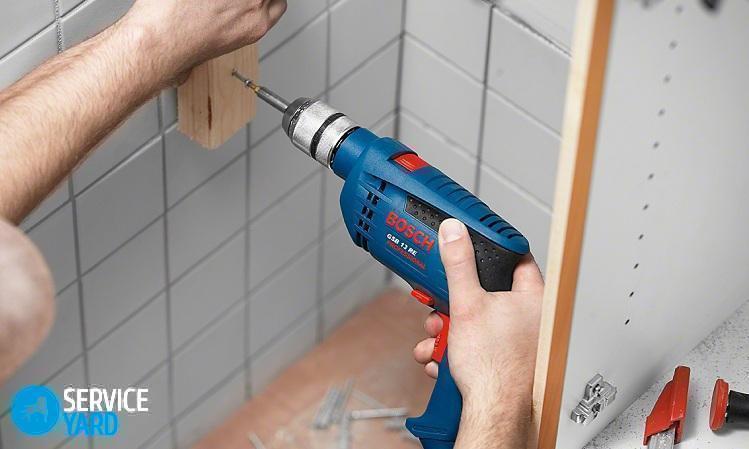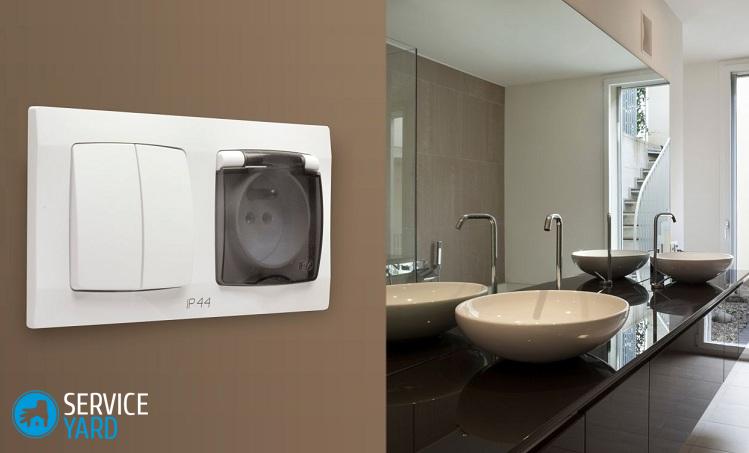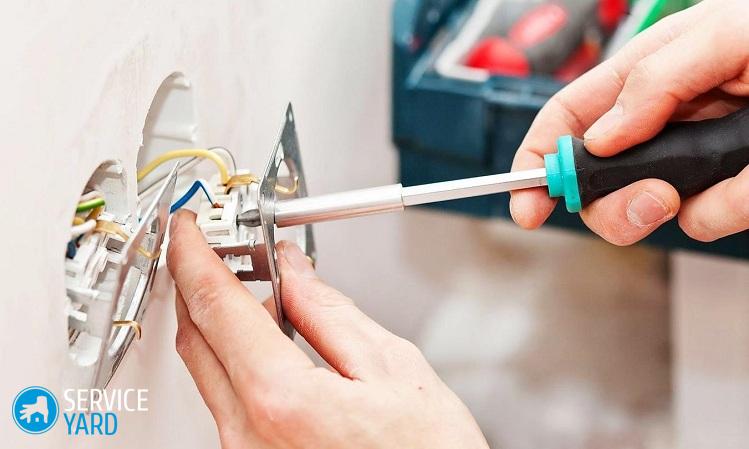How to make a socket in the bathroom?

In old houses, sockets in bathrooms were not even provided for by the project. Water perfectly conducts current, and the presence of wiring in the bathroom until a certain point was simply dangerous. The washing machine was turned on through an extension cord into a socket located in the hallway near the door. Now the situation has changed, and the inhabitants of new homes can use a washer, hairdryer, electric razor right in the hygiene room. How to make a socket in the bathroom? The process has its own subtleties, which we will discuss now.
to contents ↑Why is this possible?
Why, even at the beginning of the new millennium, people were forced to tinker with extension cords to connect the most necessary appliances in the bathroom, and the inhabitants of modern apartments can simply plug the plug into the outlet in the bathroom? Everything is very simple. Moisture resistant sockets appeared relatively recently. From that moment, everything has changed. It’s not at all necessary to choose a time for washing when nobody is at home - you can turn on the car and close the door tightly, as during shaving. By taking a bath, you can charge the phone at the same time. In general, using the bathroom has become much more convenient.
But this is not such a simple matter - installing outlets in the bathroom. Safety standards are quite strict, and they must be observed so that the desire to make life better and more convenient does not lead to tragedy. It is useful, of course, to look into the regulatory documents, but if they are not at hand, follow these rules:
- Open wiring is unacceptable - the wires must be embedded in the wall.
- All elements must be allocated in a separate group and powered by cable.
- For wiring in the bathroom there should be a separate automatic protection.
- A ground loop is required.
- A residual current device is required.
- There should be no connecting wires in the bathroom.
Important! These simple rules apply in absolutely all rooms with high humidity. When you visit the pool or sauna, nothing prevents you from inspecting how the wiring is arranged - you will not find any wires on the walls.
Grounding
In theory, any outlet should be grounded. In very old houses this is not always the case. Where the wiring has not changed for a long time, you may encounter the fact that the ground loop is absent in principle. In this case, a major overhaul is ahead, and only after it will it be possible to convert the bathroom so that it is possible to use electrical appliances.
If there is grounding in the house, and until now there has been no wiring in your bathroom, please note that you can not use for it:
- metal pipes in the bathroom;
- construction fittings.
Circuit breaker
Modern electrical equipment has a fairly large power. If you are going to use only a hairdryer or electric shaver, they will not harm the network, even if you turn them on at the same time. But this can not be said about the washing machine or electric heater. They will easily cause a short circuit, even if you turn them on separately. Therefore, we need a circuit breaker that, if there is a risk of overload, will trip and prevent troubles.
To ensure safety, a residual current device is also used. It responds to potential differences, thus recording current leakage.For example, a device shuts down the system in such fairly common situations:
- when the wires get wet;
- when something gets into the outlet.
Important! For a bathroom, a differential circuit breaker is most suitable. This is a comprehensive device that organically combines the functions of automatic shutdown and protective shutdown devices.
Connecting wires
Any wire in the bathroom is a source of increased danger. He can get wet or get a hole, and then taking water procedures and even visiting the bathroom will become a very risky business. But connecting switches and sockets in the bathroom is impossible without connectors and other elements. All switching elements must be on the other side of the wall, that is, most likely in the corridor.
to contents ↑The best location of sockets in the bathroom
When and where to put the outlet in the bathroom? First, the answer to the first question. In any case, it is more convenient to do this during the overhaul of the bathroom, when the old cladding is removed and you can safely make channels for the wires. After that, the wall is leveled, tiles are glued, and you get perfectly protected wiring.
to contents ↑Important! GOSTs, in principle, allow open wiring, but you should not do it, because the security requirements will be even more stringent, and it does not look particularly beautiful.
Choose a place
Installing switches and sockets in the bathroom is a delicate matter. To make it right, you need to know something about the bathroom itself. In particular, how to choose the right place? For this, there is such a thing as zoning. There are only four zones in the bathroom, and each has its own safety standards:
- zero;
- the first;
- the second;
- the third.
Zero zone
There are water sources in this zone:
- shower;
- bath;
- toilet bowl;
- washbasin.
Since there is open water here, which, as already mentioned, is an excellent conductor of electric current, it is better to immediately refuse to place sockets and switches in this zone. Of course, there are exceptions when a socket with an increased level of protection is installed, but it:
- costs more than any other;
- does not give a one hundred percent guarantee.
Important! However, some electrical appliances in this area can be connected - those for which a voltage of not more than 12 V. is needed. In addition, it is also possible to connect special plumbing equipment, where all necessary protection measures are provided.
First zone
It is located directly above zero. That is, in essence is the projection of water sources on the ceiling. Installing outlets here is possible, but there are limitations. For example, at 127V - it is possible, but at 220V - no.
But there are no rules without exceptions, and if you put a shower cubicle, which has a partition (that is, a roof) that separates the first zone from the zero - you can safely place a switch or outlet directly above it.
Free zones
Solving the problem of how to install an outlet in the bathroom, pay attention to zones 2 and 3. The second is at a distance of 60 cm from the zero and the first. Sockets can be installed, but when buying, pay attention to the moisture protection class - only the fourth is suitable.
Finally, in zone 3, which starts at a distance of 60 cm from the water source and lasts up to 240 cm, almost any moisture-proof sockets can be installed - the level of protection can be minimal.
to contents ↑Important! Even in the third zone, a socket can appear only if there is a distributor or residual current device.
In case of global flood
Before you install the outlet in the bathroom, it makes sense to think about something else. Even the most tidy owners periodically experience troubles with plumbing - pipe breaks, leaks in the washing machine, and more. A hose that has flown out, and a tap that they forgot to close when the water was turned off throughout the house, is not excluded. Everything happens in life, and one must also be prepared for everything. And if a flood suddenly arises, it is impossible for the outlet or switch to be under water.Therefore, they must be placed at a level not lower than 20 cm from the floor, and preferably even a little higher.
Important! Consider the fact that condensation flows down, respectively - the lower the outlet, the more moisture will be on it. For the same reasons, you should not install the connectors on the wall that goes into the staircase - the condensate especially likes cold partitions.
In a word, the farther the outlet from the bathtub and the washbasin is, the better:
- If the room is spacious enough, select a point at a distance of 2.5 m from all sources and at a height of about 30 cm from the floor - this will be an ideal place.
- In a small bathroom, the best place is the wall opposite the washbasin, at a height of at least 60 cm from the top edge of the bathtub.
What outlet to put in the bathroom?
Choosing a socket for a room with high humidity is not an easy task. You already know one requirement - the device must be protected from moisture. From other objects of this type, such sockets differ quite significantly:
- the presence of plastic curtains on the body;
- the presence of a rubber washer between the contacts and the housing;
- grounding bus.
The shutters fit very tightly, they themselves do not open, and in order to move them, some effort is required. This prevents water from getting inside. As for the washer, it serves to protect the connector and usually copes with its role perfectly - even if your neighbors have flooded you so that water flows along all the walls, it will not get to the contacts.
Most modern sockets are equipped with a grounding bus. But for those that are in rooms with high humidity, the presence of green or yellow wiring is mandatory.
About moisture protection classes
Not everyone knows about the existence of a special scale by which the degree of moisture protection is established. But you can find it on the markings, and the higher this class, the better. Outlets are usually marked with a code such as IPXY. The first digit, that is, X, means the dust protection class, the second - from moisture.
The only type suitable for small bathrooms is IP 44. Such outlets do not have conductive fragments, they are perfectly protected not only from water flows, but even from small splashes.
If no other place was found, except directly above the bathtub or washbasin, only IP 7 marking is suitable. It can even be placed under water.
Important! Design when choosing a power outlet for the bathroom is the last thing. Unfortunately, moisture-proof devices do not always look elegant, but they should be chosen.
Two words about manufacturers
Well-chosen equipment and easy to install. This applies even to such small devices as sockets in the bathroom. Therefore, pay attention to the company that released the product. Such brands should attract you:
- Legrand
- Schneider electric,
- Lezard,
- Makel.
In each case - a reasonable combination of price and compliance with safety requirements. Do not immediately grab a cheap outlet from an unknown manufacturer from the counter - you can make a big mistake.
to contents ↑Installing a power outlet in the bathroom
Did you buy a power outlet and choose a location? It's time to get to work. Take care of the tools. In this case, you will come in handy:
- crosshead screwdriver;
- indicator screwdriver;
- drill;
- crown for concrete;
- stripping machine;
- level.
The place where the outlet will be installed, as well as the part of the wall where the wiring will be laid, should already be completely free of cladding - this is why it is best to carry out such work during repair:
- At the selected location, cut a round hole in the slab - this is why you need a crown on concrete.
- Punch a vertical strob from the hole to the ceiling.
- At the upper end of the gate, drill another hole through which the wires will exit the room.
- In the hole that you cut first, install the alabaster podrozetnik.
- Get the same three-wire wire with a cross section of 2.5.
- Lay it in a shtrob and fasten with an alabaster.
- Connect the outlet into the first hole - pay attention to the marking of the wires, they should not be confused.
- You can use special crimps that will not allow the ends of the wires to crack.
- Connect the power cord to the main wiring of your apartment.
Connection to a common system has its own subtleties:
- If the outlet is designed for low-power appliances like a hair dryer or electric shaver, it can be connected to the nearest junction box.
- If a water heater or washing machine is to be plugged in, the cable must be brought to the distribution panel, and the connection is made through a circuit breaker.
to contents ↑Important! Work with wiring should be in rubber gloves.
Stock footage
A novice master can cope with electrical work if he follows the technology and safety regulations. But for those who are not very sure that they can do everything efficiently and competently, it is better to turn to specialists for help.
- How to choose a vacuum cleaner taking into account the characteristics of the house and coatings?
- What to look for when choosing a water delivery
- How to quickly create comfort at home - tips for housewives
- How to choose the perfect TV - useful tips
- What to look for when choosing blinds
- What should be running shoes?
- What useful things can you buy in a hardware store
- Iphone 11 pro max review
- Than iPhone is better than Android smartphones






